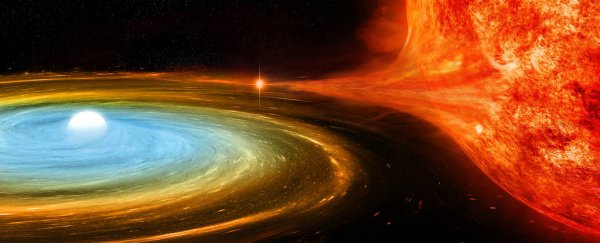When it comes to going out with style, nothing comes close to the end of a white dwarf. Their thermonuclear self-destruction ranks among the most powerful explosions in the cosmos, forcing the star to wink out of existence in a blaze of glory.
At least, that's the idea. A discovery confirms some white dwarfs fake their deaths with a lackluster performance, only to go on shining even brighter than before.
Ten years ago, supernova SN 2012Z was spotted in the nearby spiral galaxy NGC 1309, glowing briefly in a swan song that should, by all accounts, herald its annihilation.
Images of its home galaxy went back for years prior, so working out which star went bang simply required studying follow-up images to spot the now empty spaces.
"We were expecting to see one of two things when we got the most recent Hubble data. Either the star would have completely gone away, or maybe it would have still been there, meaning the star we saw in the pre-explosion images wasn't the one that blew up," says UC Santa Barbara astronomer Curtis McCully.
"Nobody was expecting to see a surviving star that was brighter. That was a real puzzle."
As unexpected as it was, the observation wasn't entirely without precedent, contributing to a growing pile of evidence that life after death might not be such an odd thing for white dwarf stars.
Once a star with our Sun's mass squeezes its last dregs of helium into carbon and oxygen, it collapses into a dense, white-hot sphere the size of our Earth. Without the mass to build bigger elements, it simmers away, cooling over the eons until eventually dimming into a cold, black lump.
If such a depleted stellar core has a generous companion star orbiting nearby, life might go on a smidge longer as it siphons off a little extra gas.
At a critical point, however, all that extra mass risks pushing the carbon into fusion, sparking a runaway reaction that unleashes a tremendous amount of energy in a blink, tearing the star apart in what's known as a Type Ia supernova.
Usually, there's nothing of note left in the space once occupied by the white dwarf – just an expanding cloud of star guts drifting out into the cosmos, faintly glowing with residual radiation.
These specific blasts are so clockwork they all burn at roughly the same brilliance, making them handy for gauging distances across the Universe.
Yet not all explosions are so standard. The more common Type Iax supernova are less like fireworks and more like damp squibs, popping slowly in a comparatively dull whimper.
They might not even be all that destructive, with signs of high-density matter with hallmarks of a thick photosphere spotted in the aftermath of a handful of these less impressive supernovae.
 (McCully et al., The Astrophysical Journal, 2022)
(McCully et al., The Astrophysical Journal, 2022)
Above: Color images of NGC 1309 both before and after SN 2012Z. The left panel shows the Hubble Heritage (pre-explosion) image of NGC 1309. The top-middle panel shows a zoom-in on the position of the supernova from the pre-explosion image. The top-right shows SN~2012Z from the 2013 visit. The middle-bottom panel shows the location of SN~2012Z in the latest observations in 2016. The bottom-right panel shows the difference image between the pre-explosion images and the observations from 2016.
Finding SN 2012Z radiating furiously after its own supernova leaves little doubt that in some, if not many cases, white dwarfs can remain intact even after going thermonuclear.
Exactly why this particular star not only fell short of ripping itself apart but happened to come back even brighter is something of a mystery. The researchers behind the discovery speculate the blast merely stirred things up, allowing its material to settle back into a less dense, more puffed-up form.
With a larger volume, the cooling remains of the white dwarf would look even more radiant than ever.
"The implications for Type Ia supernovae are profound," says McCully.
"We've found that supernovae at least can grow to the limit and explode. Yet the explosions are weak, at least some of the time. Now we need to understand what makes a supernova fail and become a Type Iax, and what makes one successful as a Type Ia."
This research was published in The Astrophysical Journal.
